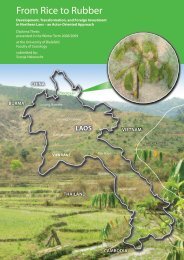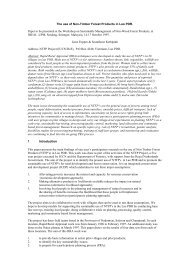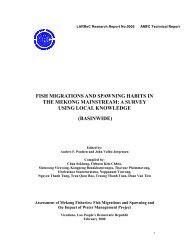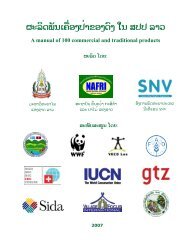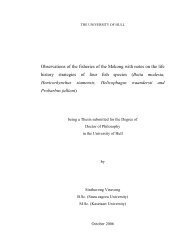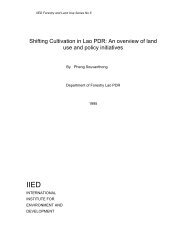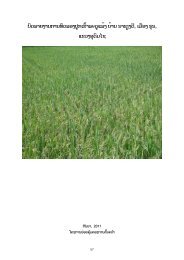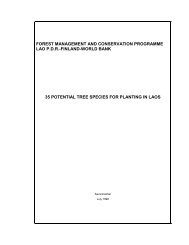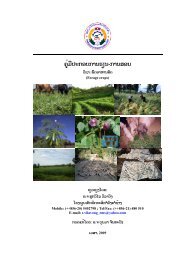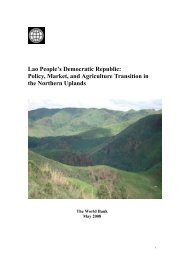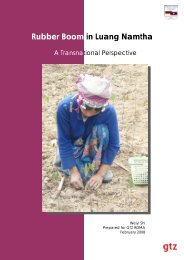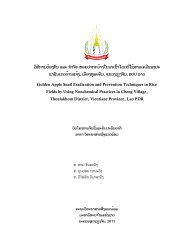improved fallow systems in the luang prabang area, lao pdr - Afaci
improved fallow systems in the luang prabang area, lao pdr - Afaci
improved fallow systems in the luang prabang area, lao pdr - Afaci
You also want an ePaper? Increase the reach of your titles
YUMPU automatically turns print PDFs into web optimized ePapers that Google loves.
Improved <strong>fallow</strong> <strong>systems</strong> <strong>in</strong> <strong>the</strong> Luang Prabang <strong>area</strong>, Lao PDR – an analysis based on farmer experiencesDiscussionDiscussionSources of errorsThe reliability of <strong>the</strong> results presented above can be questioned from a statistical po<strong>in</strong>t 3f view. Inorder to compare yields, for <strong>in</strong>stance, under <strong>the</strong> same conditions, very few po<strong>in</strong>ts of data could beused. Ma<strong>in</strong>ly, mean values were used for comparisons, but <strong>the</strong> actual data ranges can givesecond thoughts about <strong>the</strong>ir accuracy. Examples of this are given <strong>in</strong> Figures 12 and 13, where95% confidence <strong>in</strong>tervals for <strong>the</strong> means are shown.Figure 12: Same as figure 6, but presented asbars with confidence <strong>in</strong>terval.Figure 13: Same as figure 7, presented as barswith confidence <strong>in</strong>terval.Figure 12 reveals large and overlapp<strong>in</strong>g confidence <strong>in</strong>tervals for <strong>the</strong> mean yields <strong>in</strong> <strong>the</strong>comparison between normal and <strong>improved</strong> <strong>fallow</strong> (<strong>the</strong> last confidence bar is not miss<strong>in</strong>g –<strong>the</strong>re isonly one data po<strong>in</strong>t). Of course, this is a serious threat to <strong>the</strong> reliance of <strong>the</strong> presented result. On<strong>the</strong> o<strong>the</strong>r hand, <strong>the</strong> diagrams can be seen as a visualisation of a <strong>the</strong>oretical relationship that issupported by <strong>the</strong> farmers views.Figure 13 shows that <strong>the</strong> mean yields over <strong>the</strong> three parts of <strong>the</strong> plot are almost <strong>the</strong> same. withoverlapp<strong>in</strong>g confidence <strong>in</strong>tervals. This makes conclusions drawn from average figures highlyuncerta<strong>in</strong>. The data variances could be due to mistakes <strong>in</strong> <strong>the</strong> crop cuts: <strong>the</strong> 2x2-m. squaresmight have been marked <strong>in</strong>correctly and harvest<strong>in</strong>g could have been careless. Ano<strong>the</strong>r<strong>in</strong>terpretation is that <strong>the</strong> plot actually showed very vary<strong>in</strong>g yields over- and with<strong>in</strong> <strong>the</strong> parts This issupported by <strong>the</strong> author's impression from <strong>the</strong> field.The <strong>in</strong>terviews are almost <strong>the</strong> only source of <strong>in</strong>formation and data may, as shown above, haveerrors. It may be hard to remember correctly how much rice was planted and harvested ten yearsago. Ano<strong>the</strong>r problem is that <strong>the</strong> conversion from kalong is based on mean figures that may differfrom <strong>the</strong> real relations at <strong>the</strong> plot. This means that <strong>area</strong>s, production and yields all have someerrors, but must be accepted as <strong>the</strong> farmer's memory is <strong>the</strong> only way to vet this <strong>in</strong>formation.Interpretation of <strong>the</strong> resultsToo much work?A ma<strong>in</strong> problem may be that most farmers say <strong>the</strong>re was additional work <strong>in</strong> <strong>in</strong>troduc<strong>in</strong>g <strong>the</strong><strong>improved</strong> <strong>fallow</strong> species. As labour availability at sow<strong>in</strong>g is often critical, additional support from<strong>the</strong> project might be needed. This is a threat to <strong>the</strong> spread<strong>in</strong>g of <strong>the</strong> methods to o<strong>the</strong>r farmers andplots <strong>in</strong> <strong>the</strong> village. After implementation <strong>the</strong>re seems to be little extra work for <strong>the</strong> farmers,except where grasses have been <strong>in</strong>troduced.Ano<strong>the</strong>r problem might be <strong>the</strong> availability of seeds from <strong>the</strong> legumes <strong>in</strong> <strong>the</strong> quantities needed, butthis was not specifically expressed.IMPROVED FALLOW SYSTEMS IN THE LUANG PRABANG AREA, LAO PDR - AN ANALYSIS BASED ON FARMEREXPERIENCES.20040940 12



